Physical Address
304 North Cardinal St.
Dorchester Center, MA 02124
Computed tomography (CT) and magnetic resonance (MR) imaging have become the procedures of choice for defining mass lesions and traumatic abnormalities. They supplement the findings at laryngoscopy when additional diagnostic information is required to plan treatment.
Appreciation of normal anatomy is essential when analyzing cross-sectional images.
Diagnosis and extent of involvement of inflammatory conditions such as croup, epiglottitis, and retropharyngeal abscess can be confirmed with imaging.
Cross-sectional imaging is extremely useful in evaluating the patient with vocal cord paralysis.
In the laryngeal carcinoma patient, cross-sectional imaging provides crucial information about involvement of deep structures, such as the paraglottic space, cartilage, and lymph nodes.
A combination of positron emission tomography (PET) and CT along with contrast-enhanced CT is now preferred for post-therapy evaluation. PET-CT is the best modality for staging, monitoring, and surveillance of advanced head and neck squamous cell carcinoma.
In laryngeal trauma, cross-sectional imaging permits easy and rapid evaluation of the extent of cartilaginous injury, adjacent soft tissue changes, and the degree of airway compromise.
Plain film radiography and CT are very useful in localizing foreign bodies within the larynx, trachea, and esophagus.
The radiologist plays an important role in the evaluation of upper airway disorders in children and adults by providing unique and useful diagnostic information directly affecting the treatment of the patient. Computed tomography (CT) and magnetic resonance (MR) imaging have become the procedures of choice for defining mass lesions and traumatic abnormalities. These procedures can supplement the findings at laryngoscopy when additional diagnostic information is required to plan treatment.
Plain film radiography can be used to screen for acute airway obstruction and should include anteroposterior and lateral radiographs of the pharynx and laryngotracheal air column.
The lateral radiographs are useful in evaluating the tongue, adenoids, tonsils, epiglottis, aryepiglottic folds, piriform sinuses, laryngeal ventricle, and subglottic trachea, while the anteroposterior radiograph is excellent for examining the glottic and subglottic regions.
Enlarging tonsils and adenoids increase after 6 months of age and may encroach on the nasopharynx or oropharynx simulating a pathologic soft tissue mass.
In contrast to calcification seen in the thyroid and cricoid cartilages in adults, only the hyoid bone is routinely calcified in the younger child.
Plain films remain an effective and inexpensive screening examination for acute airway obstruction. Except in rare circumstances, plain film examination of the airway should include anteroposterior and lateral radiography of the pharynx and laryngotracheal air column. In cooperative patients, these films should be exposed during inspiration with the patient upright because acute respiratory obstruction may be exacerbated in the recumbent position. Although conventional soft tissue techniques are often adequate, high kilovoltage magnification technique with selective filtration better visualizes the airway with improved air/soft tissue interfaces. When plain films are inconclusive, fluoroscopy and barium studies of the esophagus may be required for diagnosis. Abnormal vocal cord motion or swallowing mechanisms, vascular impressions, mass lesions, or nonopaque foreign bodies are best evaluated by these methods. Cross-sectional imaging may also be helpful in chronic airway disease.
Lateral radiography is excellent for identifying the tongue, adenoids, tonsils, epiglottis, aryepiglottic folds, pyriform sinuses, laryngeal ventricle, and subglottic trachea ( Fig. 104.1A ). The anteroposterior airway is superb for examining the glottic and subglottic areas (see Fig. 104.1B ). During quiet inspiration, the vocal cords are abducted, and the width of the upper airway almost equals that of the trachea. During phonation of the vowel “e,” the vocal cords adduct, which narrows the glottic area. However, narrowing of the subglottic area should be considered abnormal.
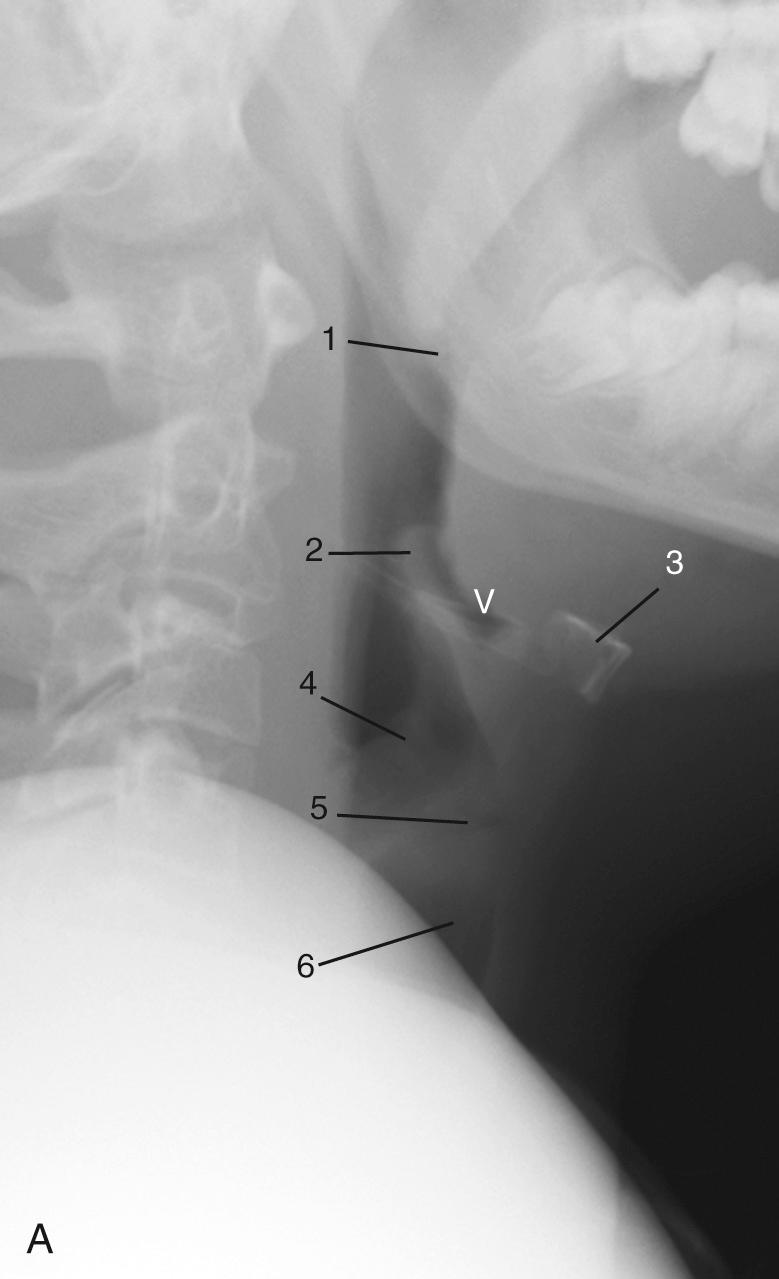
The airway may show considerable variability in children, unlike in adults. Therefore, knowledge of the normal airway anatomy is essential before attempting to recognize pathology. This requires that the patient be properly positioned for the study. Lateral airway radiography should be obtained as much as possible in full inspiration with the neck extended. If the study is performed during expiration or with forward flexion of the neck, the normal retropharyngeal soft tissue in children bulges anteriorly and may simulate a retropharyngeal mass ( Fig. 104.2 ).
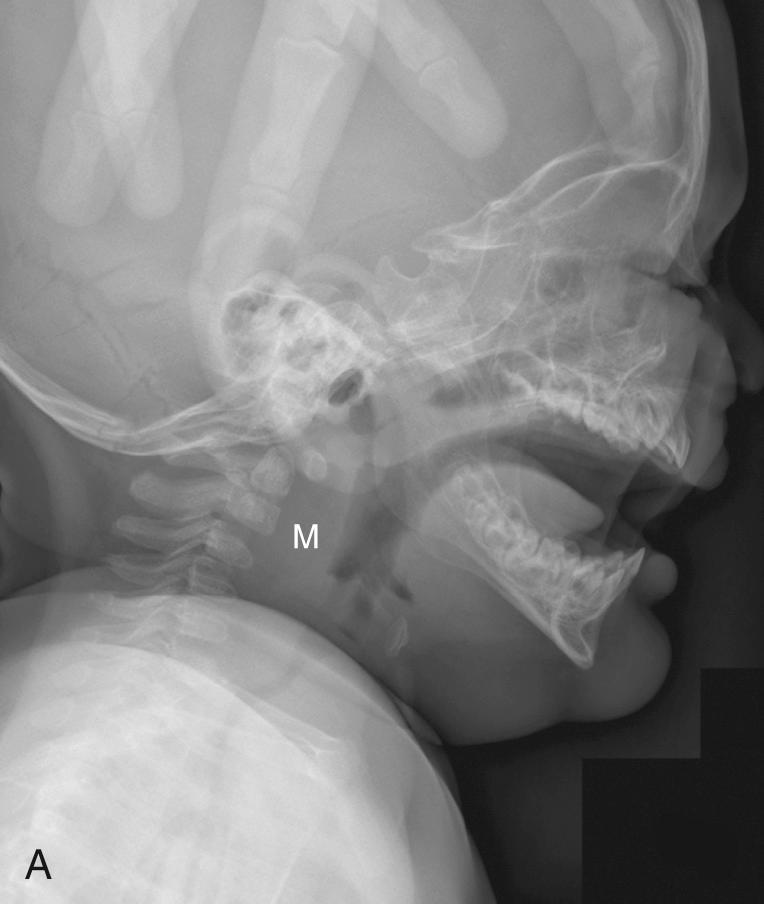
The size of the adenoids and tonsils in children and irregular cartilage ossification in adults can present significant problems in evaluation of the airway. In newborns and infants, the tonsils and adenoids are normally sparse; lymphoid tissue can be identified radiographically in all children at 6 months of age. After age 6 months, the tonsils and adenoids vary considerably in size and may encroach on the nasopharynx or oropharynx, suggesting a pathologic soft tissue mass. In most cases, these structures, even when large, are normal and are frequently noted as incidental findings on plain film radiography or cross-sectional imaging scout views or sagittal views. Occasionally, however, they can be associated with airway obstruction ( Fig. 104.3 ). The adenoids are the largest at 7 years to 10 years of age and then decline by the seventh decade. In most instances, adenoidal size can be evaluated subjectively, but objective methods of assessing adenoidal size using an adenoidal:nasopharyngeal ratio have been described. The final decision as to whether adenoid or tonsillar tissue is of symptomatic importance is clinical and not radiographic.
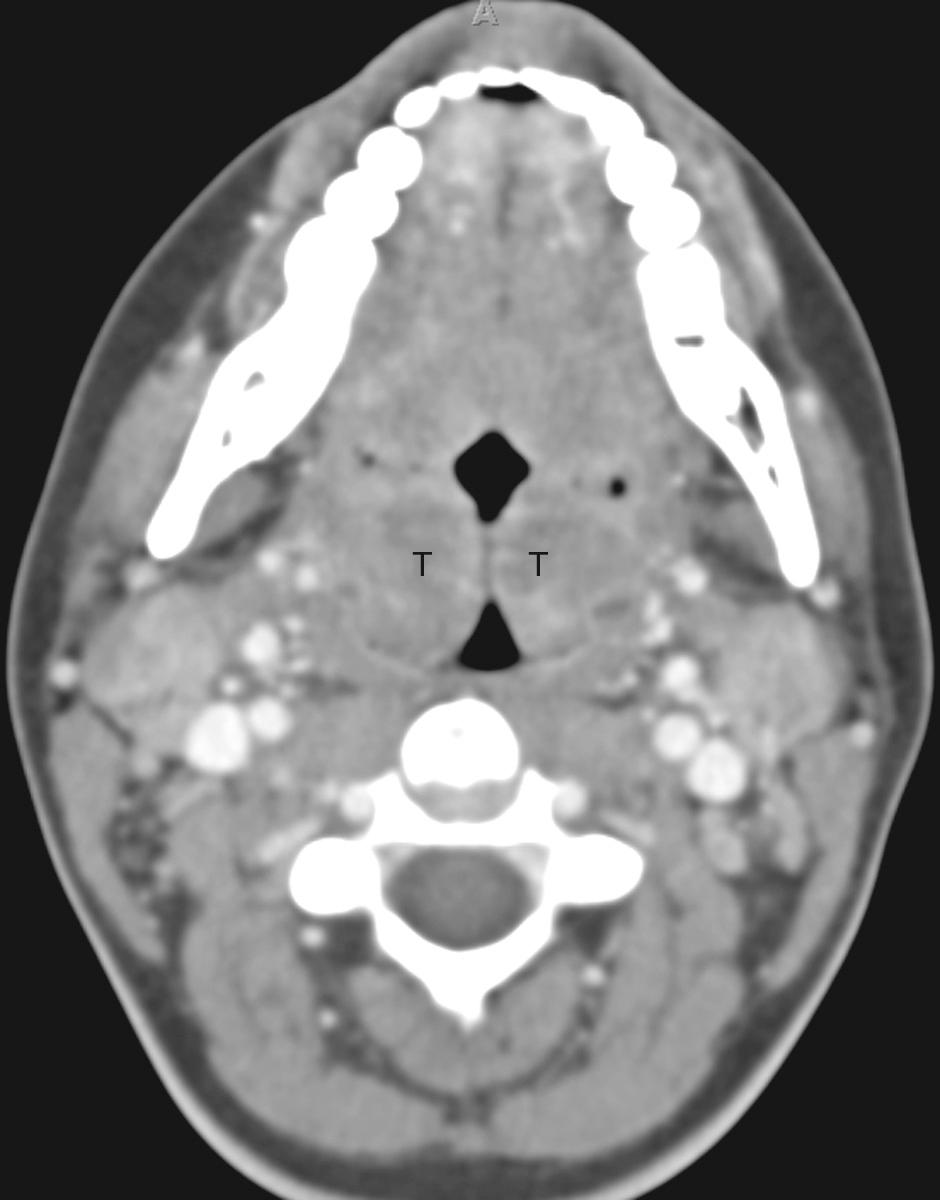
Cartilage of the neck may pose another problem because in certain adults, normal thyroid and cricoid calcifications can be irregular and incomplete, thereby simulating a foreign body or neoplastic destruction. These normal calcifications occasionally can be seen in older children, but as a rule, only the hyoid bone is routinely calcified in the younger child. Any other radiopaque structure usually is considered abnormal.
Cross-sectional imaging also adequately shows the airway. Configuration of the airway on axial or transverse images varies depending on the level of the image. At the level of the epiglottis and aryepiglottic folds, the airway is elliptical. Approaching the level of the false cords, the airway narrows and assumes a teardrop shape. The airway becomes elliptical at the level of the true cords. The term rima glottidis refers to the airway at the level of the true vocal cords. The intermembranous portion of the rima glottidis (glottis vocalis) consists of the ventral 60% of the cords, and the dorsal intercartilaginous portion (glottis respiratoria) consists of the portion between the arytenoid cartilages. Below the cricoid cartilage, the airway appears circular. The posterior membrane of the trachea may posteriorly flatten, and the normal esophagus occasionally indents the airway silhouette. Nodular projections into the airway or asymmetric tracheal wall thickening should be viewed suspiciously as subglottic tumor involvement.
Epiglottitis is best demonstrated on lateral radiographs as the edematous and enlarged epiglottis takes on a rounded, thumb-like shape.
Croup is identified most easily on anteroposterior radiographs as symmetric subglottic airway narrowing or pencil of the airway secondary to edema of the larynx and subglottic tissue. Membranous or bacterial croup shows multiple tracheal soft tissue excrescences in addition to subglottic narrowing.
A retropharyngeal abscess presents with enlargement of the retropharyngeal soft tissues, anterior displacement of the airway, and reversal of normal cervical lordosis on lateral radiographs. On CT and MR imaging, abscesses will appear hypodense and hypointense on T1-weighted and hyperintense on T2-weighted sequences, respectively. Peripheral rim enhancement is frequently present.
The maximal width of the retropharyngeal space should be more than 7 mm from C2 to C5. At C6, this thickness should not be greater than 22 mm in adults and 14 mm in children.
Epiglottitis is an inflammation of the epiglottis caused by the bacteria Haemophilus influenzae . The entire supraglottic airway may be involved, but the epiglottis and aryepiglottic folds are most extensively involved. On radiography, these normally well-defined thin structures become edematous, enlarged, and unsharp, resulting in a rounded thumb-like density in place of the normal epiglottis. The edema often encroaches on the vallecula and rarely may extend to the posterior pharyngeal wall. In addition, the hypopharynx and pyriform sinuses usually are mildly to moderately overdistended. The remainder of the airway is fairly normal, although at least 25% of children with epiglottitis have subglottic narrowing. The changes of epiglottitis are shown best on lateral radiography ( Fig. 104.4 ). Extensive manipulation of the patient should be avoided because of the possibility of inducing glottic spasm. Cross-sectional imaging is unnecessary in this condition.
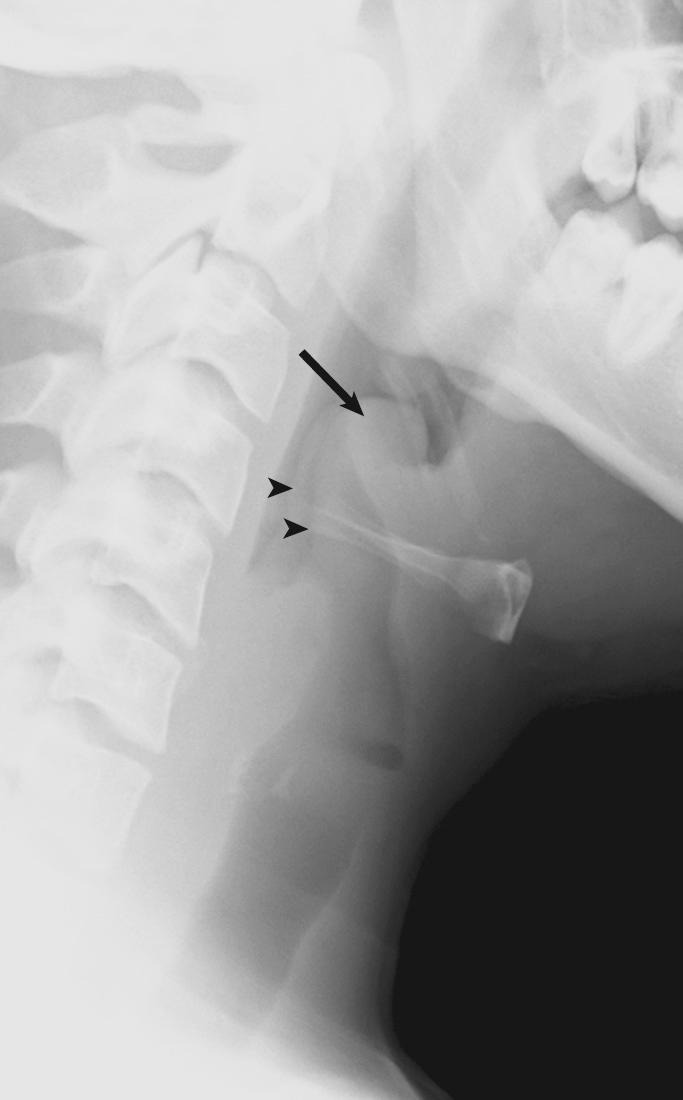
Enlargement of the epiglottis may result from various other disorders, including irritation from a foreign body or burn, tumors such as epiglottic cysts or neoplasms (e.g., lymphoma), granulomatous disease (e.g., sarcoidosis, tuberculosis, and Wegener granulomatosis), and angioneurotic edema. The radiographic findings should therefore be correlated with the patient's clinical history ( Fig. 104.5 ). On occasion, a so-called omega epiglottis—a normal anatomic variant in children in which the epiglottis is floppy, vertically positioned, and resembles the capital Greek letter omega—may be misdiagnosed as epiglottitis. An important distinguishing feature is the absence of thickened aryepiglottic folds or other edematous changes.
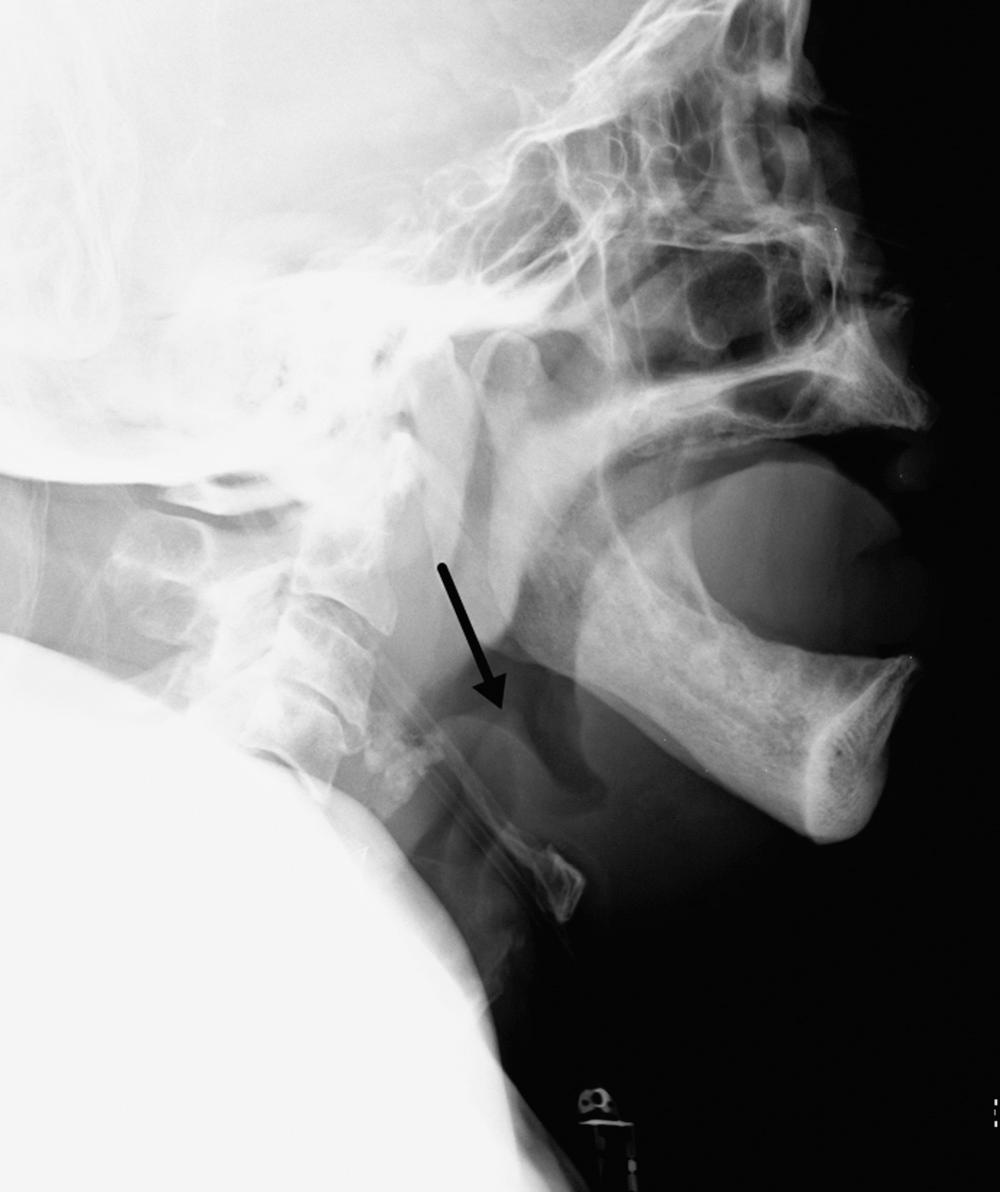
Croup is an inflammation of the subglottic larynx usually caused by parainfluenza virus type 1. It typically occurs in young children. Radiographic studies are not indicated or obtained routinely in patients with croup but are useful in confusing cases, primarily to exclude other causes of stridor. The radiographic changes are caused by inflammatory edema affecting the larynx and subglottic tissue. Radiographically, the frontal view is most helpful in the diagnosis ( Fig. 104.6 ). Symmetric subglottic airway narrowing or penciling of the airway is the major radiographic finding. In contrast to congenital subglottic stenosis, narrowing of the subglottic portion of the trachea is not fixed and may improve on expiration. The lateral view of the neck appears less helpful, although the narrowing may be noted. This projection shows hypopharyngeal airway distention, but more importantly, it establishes that the epiglottis and aryepiglottic folds are normal.
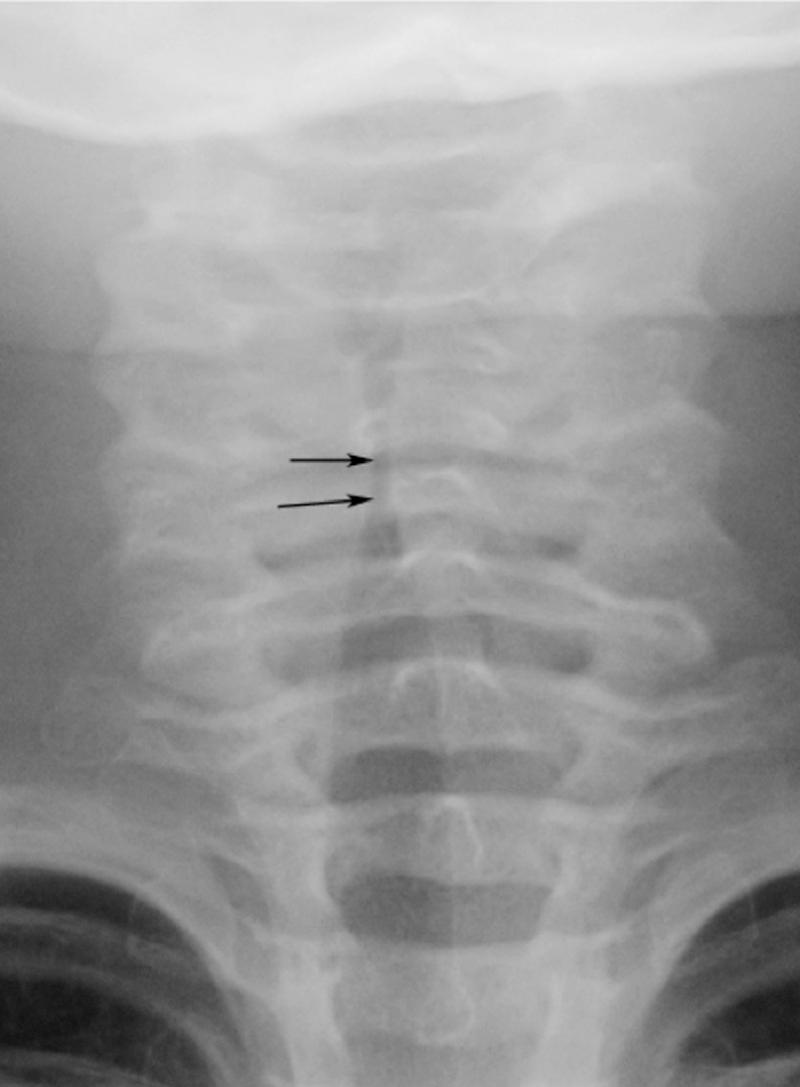
Membranous or bacterial croup and viral croup may present with similar symptoms; however, membranous croup is characterized by diffuse inflammation of the larynx, trachea, and bronchi with adherent exudate and mucus on the surface of the upper tracheal mucosa. Radiography shows subglottic narrowing and multiple tracheal soft tissue excrescences ( Fig. 104.7 ). These intraluminal lesions can be mistaken for foreign bodies, so clinical correlation is required for diagnosis.
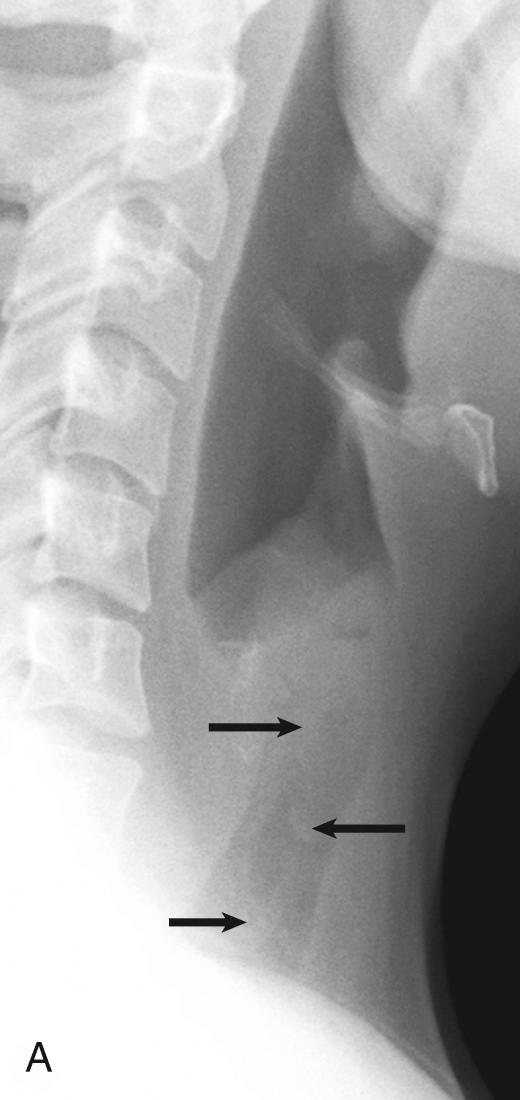
Become a Clinical Tree membership for Full access and enjoy Unlimited articles
If you are a member. Log in here